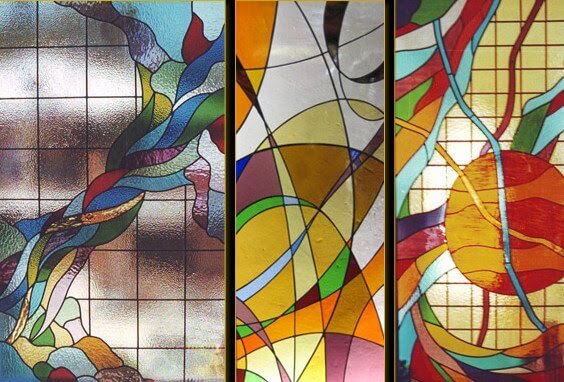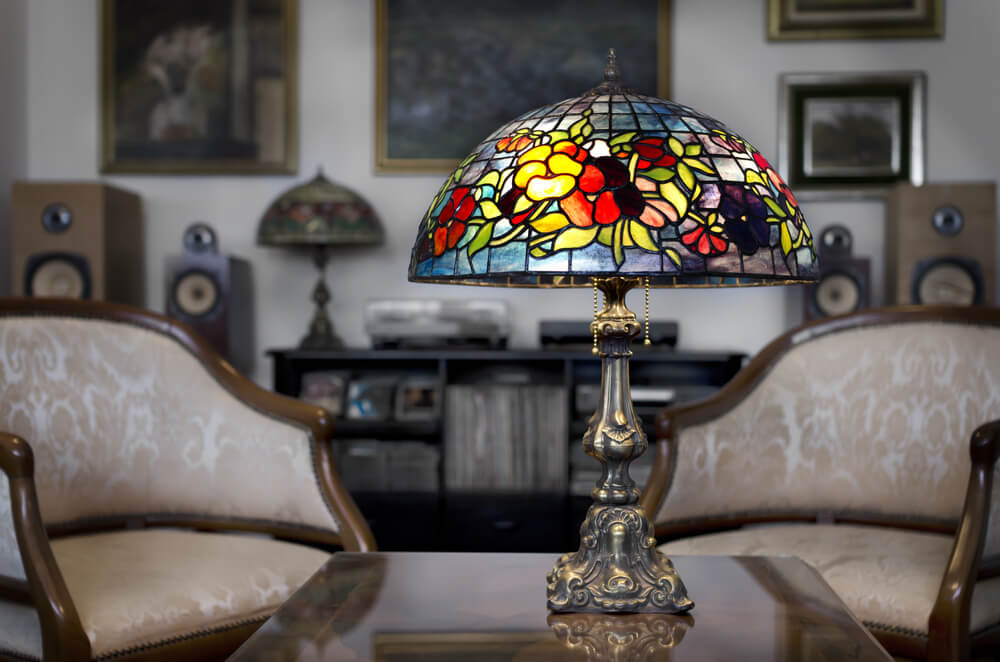Bring Color into Your Home with Stained-Glass

Who says that stained-glass is only for windows? You can actually use it on many different elements to create a one-of-a-kind decor. In our post today, read about the different ways to use stained-glass to fill your home with color.
Furniture pieces often lack the tones or design to reach their decor potential. With the right colors, they can offer your home decor much more than you could ever imagine.
Stained-glass can step in to help your pieces achieve that colorful touch you’re looking for. It can fill spaces with color and personality.
Different types of stained-glass

We usually link arts like drawing or painting with flat supports such as paper or canvases. Similarly, stained-glass also has a 2D effect but rather than paper or canvas, the support is glass.
You can find colorless glass pieces that use the glass just as it is to create a design. More often than not, these pieces feature a drawing on the glass itself.
Or, there are also colorful stained-glass or monochrome stained-glass options. Some of the designs use colors to create shapes and peaceful scenes.
Art has no boundaries and you can get lost in the options that stained-glass offers.
How do people make stained-glass or glass pieces?

Before we dive into some examples of furniture pieces with stained glass, let’s first learn about the quick and easy steps to use it.
- First and foremost, draw a design that you want your glass to have on a big sheet of paper. Use a real-size sheet of paper to create a stencil. Think of it as a map to help you create your stained-glass design later.
- Once you have your stencil, trace it onto your glass. Then, simply cut out the pieces with a glass-cutter.
- Join the pieces of glass together with an appropriate adhesive. Make sure you attach the pieces together securely.
Display cabinets for your living room

Wooden cabinets with glass doors can be the perfect piece to show off stained-glass detail. Shelving units or cabinets often have transparent glass doors so you can easily see their contents. But what can stained-glass do for a cabinet?
- Remove the glass and swap it for stained-glass instead. You can do this yourself and ensure that the colors match your living room.
- While your cabinet’s contents might not be easy to see behind the colors, the new detail will create a much more interesting setting. It can convert your cabinet into a decor centerpiece.
- Your stained-glass will reflect a style very true to the 19th century. During this period, artisan craft was highly esteemed and valued more so than any machine-production.
A beautiful lamp

Of course, we can’t skip the opportunity to talk about one of the most basic stained-glass elements throughout history – lamps. Find inspiration in the Tiffany lamp and make your own special treasure with your favorite colors.
Remember, you can also make colorless glass pieces as well. However, colorful designs are certainly more eye-catching and offer a truly enchanting light as they reflect colors.
Side-table with doors

Similar to the cabinet idea, a side-table can be another furniture piece that can feature a beautiful glass image. While the design would have to be smaller, it will bring color into any bedroom or bathroom.
You can remove the glass from any furniture piece that has it and replace it with a beautiful work of stained-glass. It’s simply the best way of creating a dynamic yet elegant setting.
Who says that stained-glass is only for windows? You can actually use it on many different elements to create a one-of-a-kind decor. In our post today, read about the different ways to use stained-glass to fill your home with color.
Furniture pieces often lack the tones or design to reach their decor potential. With the right colors, they can offer your home decor much more than you could ever imagine.
Stained-glass can step in to help your pieces achieve that colorful touch you’re looking for. It can fill spaces with color and personality.
Different types of stained-glass

We usually link arts like drawing or painting with flat supports such as paper or canvases. Similarly, stained-glass also has a 2D effect but rather than paper or canvas, the support is glass.
You can find colorless glass pieces that use the glass just as it is to create a design. More often than not, these pieces feature a drawing on the glass itself.
Or, there are also colorful stained-glass or monochrome stained-glass options. Some of the designs use colors to create shapes and peaceful scenes.
Art has no boundaries and you can get lost in the options that stained-glass offers.
How do people make stained-glass or glass pieces?

Before we dive into some examples of furniture pieces with stained glass, let’s first learn about the quick and easy steps to use it.
- First and foremost, draw a design that you want your glass to have on a big sheet of paper. Use a real-size sheet of paper to create a stencil. Think of it as a map to help you create your stained-glass design later.
- Once you have your stencil, trace it onto your glass. Then, simply cut out the pieces with a glass-cutter.
- Join the pieces of glass together with an appropriate adhesive. Make sure you attach the pieces together securely.
Display cabinets for your living room

Wooden cabinets with glass doors can be the perfect piece to show off stained-glass detail. Shelving units or cabinets often have transparent glass doors so you can easily see their contents. But what can stained-glass do for a cabinet?
- Remove the glass and swap it for stained-glass instead. You can do this yourself and ensure that the colors match your living room.
- While your cabinet’s contents might not be easy to see behind the colors, the new detail will create a much more interesting setting. It can convert your cabinet into a decor centerpiece.
- Your stained-glass will reflect a style very true to the 19th century. During this period, artisan craft was highly esteemed and valued more so than any machine-production.
A beautiful lamp

Of course, we can’t skip the opportunity to talk about one of the most basic stained-glass elements throughout history – lamps. Find inspiration in the Tiffany lamp and make your own special treasure with your favorite colors.
Remember, you can also make colorless glass pieces as well. However, colorful designs are certainly more eye-catching and offer a truly enchanting light as they reflect colors.
Side-table with doors

Similar to the cabinet idea, a side-table can be another furniture piece that can feature a beautiful glass image. While the design would have to be smaller, it will bring color into any bedroom or bathroom.
You can remove the glass from any furniture piece that has it and replace it with a beautiful work of stained-glass. It’s simply the best way of creating a dynamic yet elegant setting.
All cited sources were thoroughly reviewed by our team to ensure their quality, reliability, currency, and validity. The bibliography of this article was considered reliable and of academic or scientific accuracy.
Rodríguez Vega, Julián: Manual del carpintero de muebles y edificios, Enciclopedia Hispano-Americana, París, 1858.







